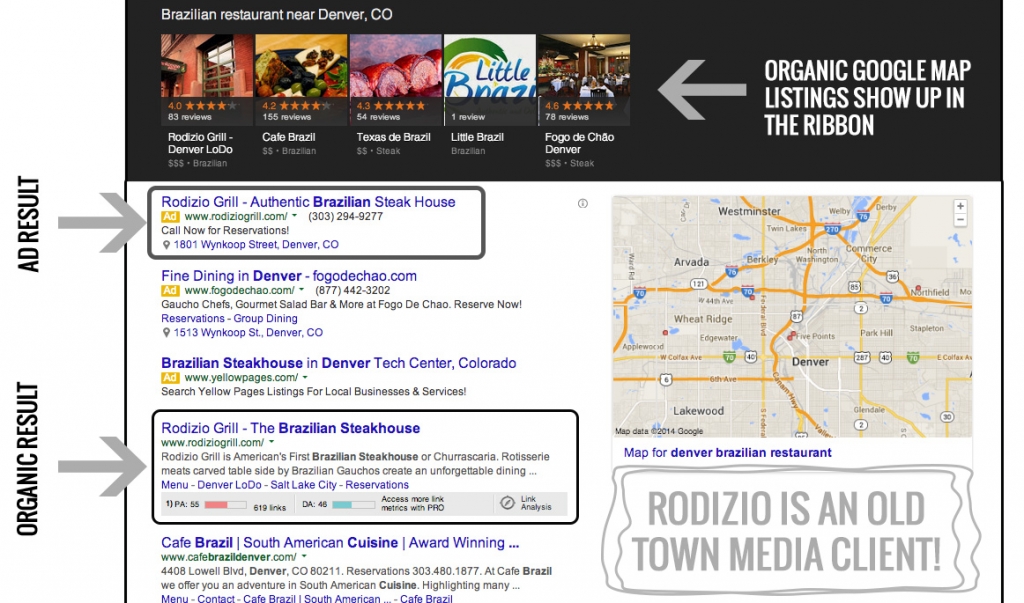What is Google AdWords?
(Complete side note: believe it or not, prior to writing this blog I spent about 10 minutes trying to rationalize whether it would be correct to say “What is Google AdWords” or “What are Google AdWords.” I settled on the verb “is” due to the fact that AdWords is considered a platform – singular. Please ignore the inconsistency in my drawing!)
Google AdWords is Google’s advertising platform in which online advertisers bid on keywords in varying amounts in order for their clickable ads to appear in Google’s search results (and Google’s partners’ search results).
Example:
Below is an example of the different ways your business can show up in search engine results, this example is from Old Town Media SEO client, Rodizio Grill.

So…How does AdWords Work?
Google AdWords is kind of like an onion… there are a lot of layers and if you’ve never used AdWords before, it can get pretty confusing.
You start with determining your campaign. In the drawing I made below, (yes, I literally drew that at my desk), you can see that the campaign is the starting point for AdWords. The campaign is the overarching theme of whatever it is that you’re going to be advertising. In the example below you can see that I chose something super-basic… “fruit.”
From your campaign, you then determine segments of your campaign that are different enough to warrant Ad Groups. Your Ad Groups are the next level in organizing your ads. Each Ad Group has its own set of Keywords – which then trigger the ads themselves. It is okay if your ads are similar or overlap across Ad Groups, however it’s important to try and keep your keywords unique to each Ad Group (otherwise your ads will compete against one another).
Keeping your Ad Groups and all that fall under that umbrella (including the landing page for your ads, the headline of your ads and the keywords triggering your ads within that ad group) highly specific will result in better quality scores and a better chance your ad will show up more often and in better placement. Better quality scores also result in paying less for clicks!
How does the auction actually work?
Since you’re bidding for keywords, there has to be an auction! How it works is a little bit complicated, but here’s a quick breakdown:
Advertisers set a maximum CPC (cost per click) – this is the amount of money you’re willing to pay per click on your ad. However, your maximum CPC doesn’t necessarily translate directly into your actual CPC. Your actual CPC incorporates a number of things including your Ad Rank (maximum CPC x Quality Score) as well as your competitors Ad Rank, historical CTR (click through rate) of the keyword being bid on, Display URL and max CPC. Overall, the better your quality score, the better off you are.
Here are some quick tips for getting the most out of your AdWords:
- Never run just one ad per Ad Group. Instead, create ads with varying headlines and verbiage so that you can test styles against on another. A/B testing will help you refine your ads for better performance.
- Set up automated rules so that you aren’t spending too much money on ads or losing out on winning bids because your budget is focused on poorly performing ad groups.
- Here are some good rules to follow in terms of automated rules:
- Pause when # of impressions >200
- Pause when CTR <1&
- Pause when Avg. Pos. >1.8
- Pause when QS <4
- Pause your ads when CTR is more than you want to pay for!

